| |
Native American Relics
 I'm creating these
pages as a way to catalogue my collection and learn about point typology.
It's also the place where I'll be recording the notes I take while doing
research on ancient America. These points are not for sale though I am
occasionally interested in purchasing old collections especially if they are
personal finds. Personal recollections by the finder about the finding of the
artifacts are definitely of interest to me. Many times the story is more
interesting than the point itself. I'm creating these
pages as a way to catalogue my collection and learn about point typology.
It's also the place where I'll be recording the notes I take while doing
research on ancient America. These points are not for sale though I am
occasionally interested in purchasing old collections especially if they are
personal finds. Personal recollections by the finder about the finding of the
artifacts are definitely of interest to me. Many times the story is more
interesting than the point itself.
Rob Horne
Historic Points
Pre-Columbian to modern times |
Mississippian
Points
400 B.P. to 1300 B.P. |
Woodland Points
1300 B.P. to 3,000 B.P. |
Late Archaic Points
3,000 B.P. to 5,000 B.P. |
Mid Archaic
Points
5,000 to 6,500 B.P. |
Early
Archaic Points
6,500 to 9,000 B.P. |
Paleo Points
9,000 B.P. to 11,500 B.P. |
|
Stone Tools - Celts, Net weights, Axes, Banner Stones |
|
Dalton's |
Pendants & Gorgets |
|
Ex-Stagecoach
Lane Collection |
Ex-Stangland
Collection |
Ex-Lillian
Martel Collection |
Point Notes |
| |
|
Musical Instruments |
Early Archaic Points
6,500 to 9,000 B.P.
|
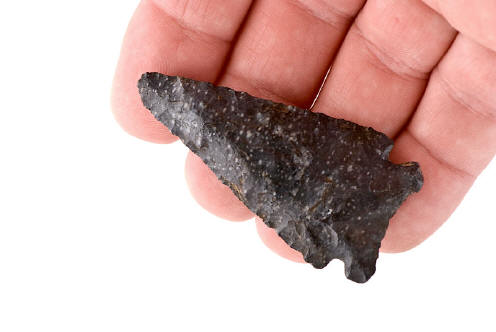
|
Big Sandy
Early to late Archaic, 10,000 - 3,000 B.P.
L 2.47" W 1.26"
Description: The
red tint you see in photo #1 is heavy patina covered in dirt! Reverse has
much less covering (side down for +9 millennium). Elongated triangular shape
with a concave base. Maximum length is 6.35 cm (2 5/8"), max width is at
ears 3.24 cm (1 1/4"), max thickness 0.7 cm (1/4"). Cross-section is plano-convex.
Blade edges--looking directly at tip--is s-curvate. Blades very sharp. Tip
shows use but is sharp. One of the earliest types of the side notched
points. Found in northern extreme of normal sites, commonly found south of
the Ohio river valley, all the way down the Mississippi.
Most artifacts from the
Secrist collection show inscribed farm survey locations: S(outh)1/2
E(ast)1/2 N(orth)E(east) 1/4 S(ection)10 Twp (Township)2 SR12E (South of
Range 12 East) WytCo O (Wyandot County Ohio). Date Found:
between 1861-1930. There were 4 farms: 1) SE1/4.... 2) S1/2....
3) W1/2.... 4) NE1/4.... . W 1/2 is far-and-away the rarest! The first
of the 2,000+ points in the Secrist/Secrist collection sold were in 2001,
NONE BEFORE. Secrist gave-traded a few away in the 1910's. Seller unwrapped
the forgotten points in 1998 on basement shelves after the death of the 4th
generation. Now passed thru 5 generations of the Secrist family, stored in
1951 newspaper (Upper Sandusky) and cardboard boxes, full of dirt and sand.
Material:
High grade of Upper Mercer Coshocton Black Flint. Black with grey mottling.
Age: Early Archaic
period 8,000-6,000 BCE.
Found:
Wm Secrist Wyandot Co Wharton Ohio. Farm # 1. Marked in a blue/black
India ink: SE 1/4 1899-1-14
Grade: 9. No damage, prefect in size
and workmanship. OHS in Columbus archive scan Feb 2001" # 12.
Overstreet 10 p.350
- A small to medium size, side notched
point with early forms showing heavy basal grinding, serrations and
horizontal flaking. This type may be associated with the Frazier point,
being an un-notched form. Some examples have been carbon dated to 10,000
B.P., but most are associated with mid archaic times. |

 |
Datil
Early Archaic, 7000 - 6000 B.P.
L 1 7/16" W 3/4"
Overstreet 10 p. 835 - The Southern portion of the
southwestern states. A small/dark knife with serrated blade. The stem is
short and rectangular to rounded. Shoulder are straight to obtuse and very
small to non existent in relation to overall size of the point.
This point was reportedly
found in Arizona
|

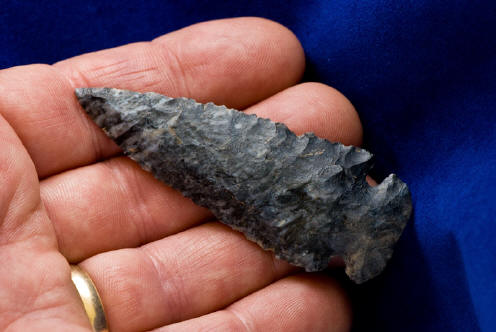 |
Dovetail
Collector's Grade w/Dual COA's
L 2 7/8" W 1 1/16"
Early Archaic period in the 8,500 B.P.
range A blue and cream
Coshocton Dovetail found by Michael Renihan, spring 2005 in Hendricks Co.,
Indiana. This is a high-quality Dovetail made from a colorful, high-grade
Coshocton flint. It is 2 7/8" in length and 1 1/16" wide. Nice secondary
edge work and a very smooth feeling artifact.


2005 Jackson Galleries COA &
2006 Davis Artifacts G-9 COA.
Midwestern to Eastern states. A medium to
large size, broad, thin, elliptical, corner notched point with dovetail
base. First stage forms are not beveled. Beveling on opposite sides of each
face occurs during the re-sharpening process. The base is convex and most
examples exhibit quality flaking. -
Overstreet 10 p.474

Pictured in Ancient Indian Artifacts - Volume 2 - Page 126
by Jim Bennett |

|
 |
Dovetail
Early Archaic period in the 8,500 B.P.
range
Rush Co IN
Harrodsburg Chert
3 13/16" long x 1 1/8" wide

Tom Shenk COA - G10
Midwestern to Eastern states. A medium to
large size, broad, thin, elliptical, corner notched point with dovetail
base. First stage forms are not beveled. Beveling on opposite sides of each
face occurs during the re-sharpening process. The base is convex and most
examples exhibit quality flaking.
Overstreet 10 p.474 |

|

|
Dovetail
Early Archaic period in the 8,500 B.P.
range
Clinton County, Ohio
Hornstone
L 1 7/8"
W 1 7/16"

Jackson COA
Midwestern to Eastern states. A medium to
large size, broad, thin, elliptical, corner notched point with dovetail
base. First stage forms are not beveled. Beveling on opposite sides of each
face occurs during the re-sharpening process. The base is convex and most
examples exhibit quality flaking.
Overstreet 10 p.474 |

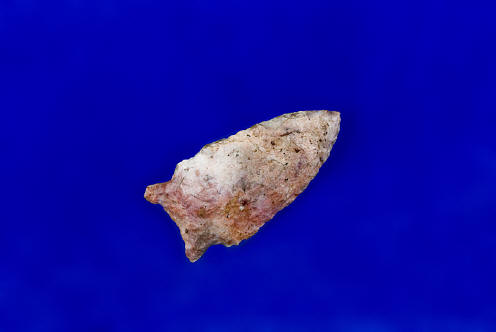 |
Graham Cave
Early to Mid Archaic, 9000 - 5000 B.P.
Found in Boone County Missouri by Jim Bruce
L 2.25" W 1.12"
Midwestern states. A medium to large size, narrow, side-notched point with
recurved sides, pointed auricles and a concave base. Rarely,
examples have been found fully fluted. Similar to White River points found
in Arkansas & Oklahoma. -
Overstreet 10 p.735
|

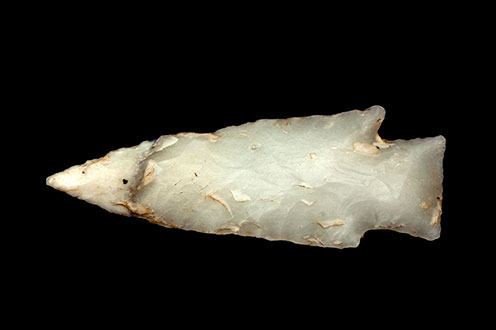 |
Hardin
Early Archaic, 9000 - 6000 B.P.
L 3-1/15" W 1-1/8"
White Novaculite
South Arkansas

COA Dwain Rogers |

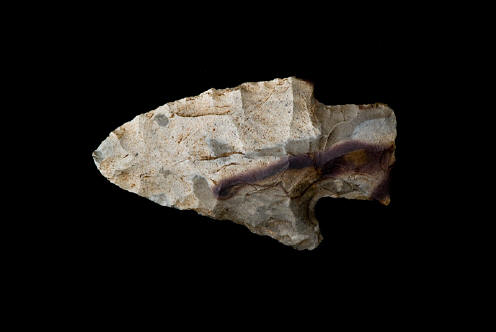 |
Hardin
Early Archaic, 9000 - 6000 B.P.
L 2"
Brown Chert
Lafayette County, Arkansas
Midwestern to Eastern states. A large size,
well made triangular barbed point with an expanded base that is usually
ground. Re-sharpened examples have one beveled edge on each face. -
Overstreet 10 p. 408 |

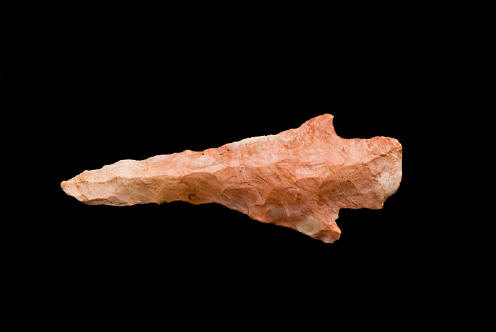 |
Hardin Drill
Early Archaic, 9000 - 6000 B.P.
L 2.54" W .98"
Southeast Missouri
by Gerald Lyne and purchased from his family at the estate auction. Gerald
never bought or sold any artifact. His whole collection was personal finds.
Located everywhere. Although many drills where made from
scratch, all points where made into the drill form. Usually heavily
resharpened and broken points were salvaged and rechipped into drills. |

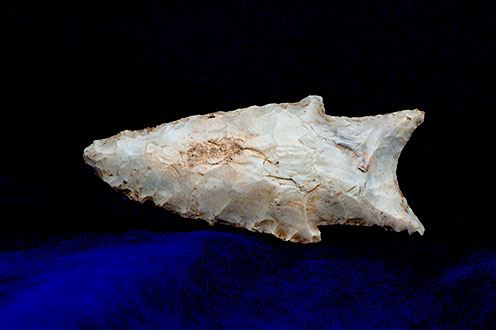 |
Holland
Early Archaic
L 3-18" W 1-3/8"
Arkansas, Cotter Dolomite
Ex-Johnny Parnell, Ex-Tomas Payne collection
Midwestern states. A medium
to large size lanceolate blade that is very well made. Shoulders are week to
nonexistent. Bases can be knobbed to auriculate and are usually ground. Some
examples have horizontal to oblique transverse flaking. Related to Dalton
Sloan points. Overstreet 10 p. 748
|
 |

Baker COA - G9 |
|

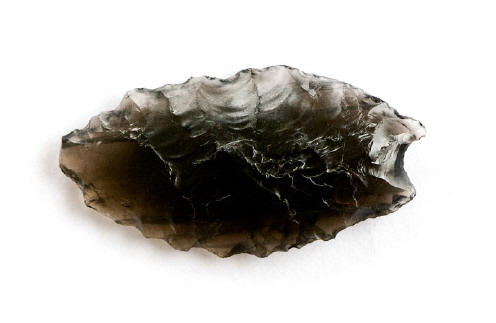 |
Humboldt
Constricted Base Dart
Point
Early to Mid Archaic, 7000 -
5000 B.P.
L 1.7" W .900" .250" thick
Gem quality Davis Creek translucent obsidian
Alturas California
Excurvate blade edges and base much
narrower than the blade with delicate ears formed in line and proportion
with the contours of the base and blade.
Noel D. Justice
Used with atlatl dart foreshaft.
Great Basin states,
especially Nevada. A small to medium size, narrow, lanceolate point with a
constricted, concave, eared base. Some examples have faint shoulders.
Parallel, oblique flaking occurs on many examples. -
Overstreet 10 p. 1051 |

 |
Johnson Point
From the early to
middle Archaic period, 9000 - 5000 B.P.
Independence County, Arkansas
1.86" L x 1.14" W
Novaculite
From the Ex collection of Johnny Parnell
Mississippi
to Oklahoma. A medium size, thick, well made, expanded stem point with a
broad, short, concave base. Bases are usually thinned and grinding appears
on some specimens. -
Overstreet 10 p. 607

Baker COA -
Grade: 8
|

|
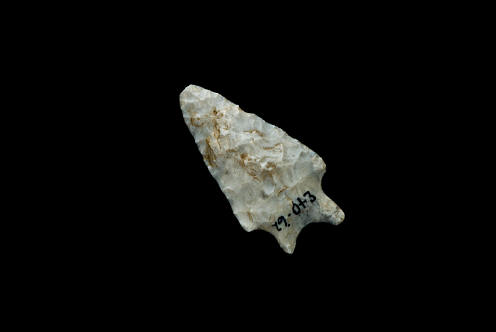
|
Kamawaha Stemmed
Early Archaic, 8200 - 5000 B.P.
Description: Maximum length is 1 7/8" (4.55cm) [large for type], max
width is at ears 1" (2.4cm), max thickness is a center ridge running from
near tip to area just above ears 1/4" (0.64cm). Weight is 5 grams. Point is
triangular in shape and blades are straight, sharp. Tip dull, impact, no
patina (finders damage). Base has larger shoulders than most of this type,
suggesting a larger point resharpened with diagnostic serration on edges.
Well made with nice shape.
Material: Flint Ridge flint of a grey/blue color.
Age: Early Archaic 6,210 BCE +/- 100.
Found: Wm Segrist Wyandot Co Wharton Ohio (farm #1). Marked in a
black India ink: E40 '62.
Grade: 6, tip chip. Dirt in fracture shelves, un-cleaned. OHS in Columbus
archive scan Feb 2001" # 191-196.
Overstreet 10 p. 419
- West Virginia
into Southeastern states. First identified at the St. Albans site, Kanawa
Co., WVA. A small to medium size, fairly thick, shallowly-bifurcated stemmed
point. The basal lobes are usually rounded, expanding and the shoulders
tapered to horizontal and can turn towards the tip. Believed to be the
ancestor to the Stanly type. |

 |
Kirk Corner Notched
Early to
middle Archaic period, 9000 - 6000 B.P.
Carter Co., Kentucky
Ex - Connelly Collection
Material: Carter Cave
L 1 1/2"
W 1 1/8"
Southeastern states. A medium to large size,
corner notched point. Blade edges can be convex to recurved and are finely
serrated on many examples. The base can be convex, concave, straight or
auriculate. -
Overstreet 10 p.420
|

Jackson COA |

Another
Example |

Another
Example |
|

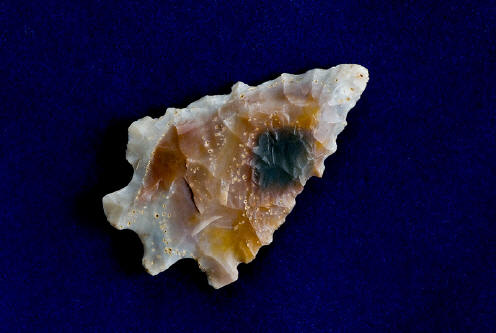 |
Kirk Stemmed-Bifurcated, Sonora
Early Archaic, 9000 - 7000 B.P.
L 1.68" W 1.06
Highly Colorful
and Collectible Sonora Chert with "bulls-eye". It was found in Fayette
County, Kentucky. Ex- Sam Cox, and purchased from the personal collection of
Monty & Judy Pennington
Southeastern to Eastern states. A medium to
large size point with deep notches or fine serrations along the blade edges.
The stem is parallel sided to expanded and is bifurcated. Believed to be an
early form for the type which later developed into Stanly and other types.
Some example have a steep bevel on the right side of each blade. -
Overstreet 10 p.425
*A fair point
with some ancient nicks, distinctive for it's bulls-eye which was reflected
in the slightly higher price.

Another
Example |

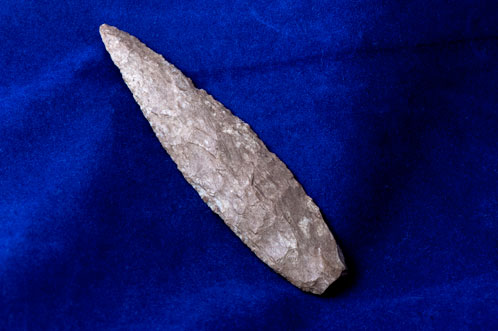 |
Lerma
Early Archaic to Mid-Archaic, 10,000 - 5000 B.P.
L 4-1/16" W 15/16"
Dickson County, Tennessee
Fort Payne Chert
Ex-Arthur Smith collection
Sometimes referred to as a "Trans-Paleo" point.
Siberia to Alaska, Canada,
Mexico, South America and across the U.S.. A large size narrow, thick,
lanceolate blade with a rounded base. Some western examples are beveled on
one side of each face. Flaking tends to be collateral and finer examples are
thin in cross section. -
Overstreet 10 p. 430
|

Baker COA |
-Edit_small.jpg) |
|

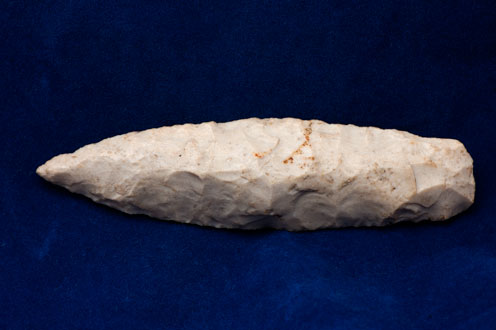 |
Nebo Hill
Early Archaic, 7500 - 6000 B.P.
L 4-1/8" W 1-1/16"
Schuyler County, Illinois
Burlington Chert
Ex Ed Armel Collection
Missouri & Kansas. A large
size, narrow, thick, lanceolate blade with convex sides that gently taper to
the base. On some examples, the basil area is determined by the presence of
slight shoulders. Collateral flaking does occur on some examples.
Overstreet 10 p. 766
 |

 |
Palmer
Early Archaic, 9000 - 6000 B.P.
Whiteside County, Illinois
L 1.21" W .81
A small size, corner notched , triangular point with a ground concave,
convex, or straight base. Many are serrated and large example would fall
under the Pine Tree or Kirk type. -
Overstreet 10 p. 458

Better example from New York
L 1-1/2" W 3/4"
|

 |
Pine Tree
Early Archaic, 8000 - 5000 B.P.
L 1.56 " W .91"
Mead Co. Kentucky
Southeastern States. A
medium to large size, side notched, usually serrated point with parallel
flaking to the center of the blade forming a medium ridge. The bases are
ground and can be concave, convex, straight or auriculate. Developed from
the earlier Greenbrier point. Smaller samples fall in the Palmer type-
Overstreet 10 p. 464
|

 |
Rice Lobbed /
Possible MacCorkle
Early Archaic 9000 - 5000 B.P.
L 2.49" W 1.67"
Ex-Stagecoach Lane Collection
Midwestern to Northwestern states. Medium to
large bifurcated to lobbed base. Slight barb nicks.
Overstreet 10 p.472
 |

|
.jpg) |
Searcy
Early to Middle Archaic, 7000 - 5000 B.P.
Ripley County, Missouri
White Chert
A small to
medium size, thin, lanceolate point with a squared hafting area that (usually) has concave
sides and base which is ground. Many are serrated.
_small.jpg)
JIM BENNETT COA
|

|
 |
Searcy
Early to Middle Archaic, 7000 - 5000 B.P.
Boone
Chert
L 3.23" W
1.09"
From the
collection of Johnny Parnell and is from in and around Independence county,
Arkansas. A small to medium size, thin, lanceolate point with a squared hafting area that (usually) has concave
sides and base which is ground. Many are serrated.
|

Baker COA -
Grade: G8 |
-Edit_small1.jpg) |
|

 |
Turin
Early Archaic, 8000 - 7500 B.P.
Illinois, Missouri,
Nebraska northward. A small to medium size side-notched point with an
auriculate base that is concave. Notching occurs close to the base and the
shoulders are barbed. Bases are ground. -
Overstreet 10 p.804
|

|

|
Unknown & Exhausted
Possible Meserve - Early
Archaic, 9000 - 8500 B.P.
1" x 13/16"
Arizona
Overstreet 10 p. 862 |

Back to Top
| |
|
Useful
Resources
|
|
|

Authentic
Artifact
Collectors
Association
______
Overstreetid.com
The Official Overstreet Indian
Arrowhead Identification Online Database
______
|
|
|
|
|
|
|